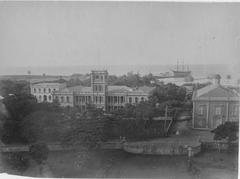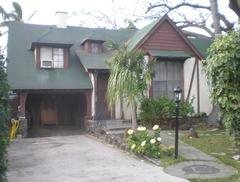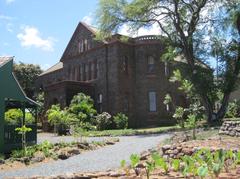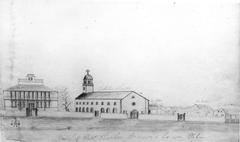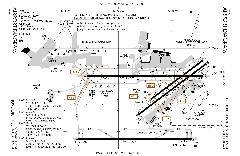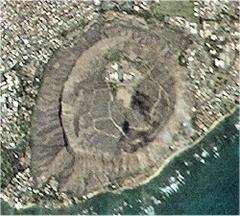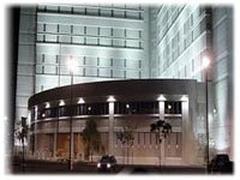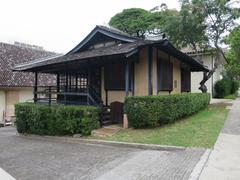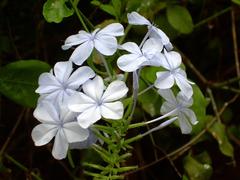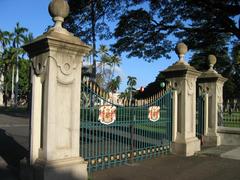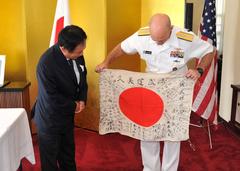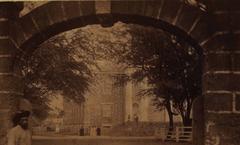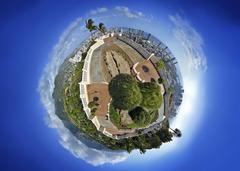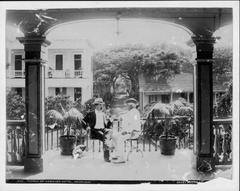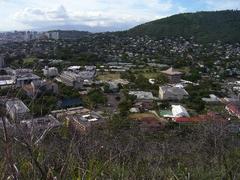Hawaii State Capitol Visiting Hours, Tickets, and Historical Sites in Honolulu
Date: 14/06/2025
Introduction
The Hawaii State Capitol in Honolulu is a striking departure from traditional American state capitol buildings, blending modernist architecture with deep cultural symbolism and civic purpose. Designed in the “Hawaiian international architecture” style, it reflects Hawaii’s unique natural environment, indigenous heritage, and political journey from monarchy to U.S. statehood. The Capitol’s open-air rotunda, reflecting pools, and volcano-shaped chambers embody the spirit of aloha, transparency in governance, and the islands’ volcanic origins (Docomomo US; Atomic Ranch; Historic Hawaii).
Since its dedication in 1969, the Hawaii State Capitol has not only served as the seat of government but also as a living symbol of community, openness, and cultural convergence. Its central downtown location makes it a gateway to other historic landmarks like ʻIolani Palace and the King Kamehameha Statue, providing visitors with a comprehensive experience of Honolulu’s civic and royal heritage (The Tourist Checklist; Hawaii Guide).
Whether you’re a history enthusiast, architecture fan, or a curious traveler, this guide offers everything you need to plan your visit—including hours, tickets, accessibility, and tips for exploring nearby attractions.
Table of Contents
- Early Legislative Roots and the Need for a New Capitol
- Planning, Design, and Construction
- Symbolism and Architectural Innovation
- Transition from ʻIolani Palace to the Modern Capitol
- Visiting the Hawaii State Capitol: Hours, Tickets, and Accessibility
- Nearby Attractions and Travel Tips
- Visual Highlights and Interactive Experiences
- Frequently Asked Questions (FAQ)
- Summary and Travel Tips
Early Legislative Roots and the Need for a New Capitol
The Hawaii State Capitol has its roots in the islands’ political evolution. For over seven decades, the historic ʻIolani Palace housed the legislature and was a symbol of both the Hawaiian Kingdom and the U.S. territory. However, by the late 1930s, the palace’s facilities were no longer sufficient for a growing government. In 1939, the Territorial Planning Board began seeking a new site for the government’s seat, initiating a multi-decade process shaped by debates over design and location (Docomomo US).
Hawaii’s admission as the 50th U.S. state in 1959 was a turning point, as the legislature finally designated the block mauka (toward the mountains) of ʻIolani Palace as the site for the new capitol (Docomomo US).
Planning, Design, and Construction
Formal planning began in 1960, led by Belt, Lemmon & Lo (Architects Hawaii Ltd.) and John Carl Warnecke & Associates. Their aim was to create a building that encapsulated the essence of Hawaii’s environment and culture while serving as a modern seat of government (Architectuul; The City Lane).
Groundbreaking occurred in November 1965, and by March 15, 1969, the Hawaii State Capitol was officially dedicated. The $24.5 million project was the largest architectural endeavor ever undertaken in Hawaii at the time, involving nearly 40 architects and engineers (TripSavvy).
Symbolism and Architectural Innovation
The Capitol’s “Hawaiian international architecture” diverges from neoclassical domes, instead offering a structure rich in local symbolism (Architectuul). Notable features include:
- Reflecting Pools: Encircle the building, symbolizing the Pacific Ocean.
- Volcano-Inspired Chambers: Legislative chambers are cone-shaped, referencing the islands’ volcanic origins.
- Palm Tree Columns: Forty palm-like columns, each 60 feet high, surround the building. Sets of eight columns per side represent the eight main Hawaiian Islands.
- Open-Air Rotunda: The central rotunda is open to the sky, inviting natural light and embodying transparency (Docomomo US; Historic Hawaii).
- Numerical Symbolism: Motifs in sets of four and eight reference the four major Hawaiian gods and the eight main islands (DGuides).
Governor John A. Burns, a champion of the project, underscored the building’s openness and connection to Hawaii’s cultural values at its dedication (Historic Hawaii).
Transition from ʻIolani Palace to the Modern Capitol
With the Capitol’s opening in 1969, Hawaii’s government moved from the royal palace to a building designed for a modern democracy, while ʻIolani Palace became a museum preserving royal heritage (Hawaii Activities). The Capitol’s design reflects the integration of indigenous traditions and American democratic ideals, fostering civic participation and community engagement.
Visiting the Hawaii State Capitol: Hours, Tickets, and Accessibility
Location
415 South Beretania Street, Honolulu, HI
Visiting Hours
- Monday–Friday: 8:00 AM – 4:30 PM (some sources note 7:45 AM opening; check the official website for the most current information)
- Closed on weekends and state holidays
Admission & Tickets
- Admission: Free
- Tickets: Not required for entry or participation in standard tours
Tours
- Self-Guided: Explore at your own pace using available brochures and informational plaques.
- Guided Tours: Offered on weekdays by advance arrangement. Contact the Governor’s Office or visitor center for details.
Accessibility
- Full wheelchair accessibility, with ramps, elevators, and accessible restrooms.
- Service animals permitted.
Travel Tips
- Wear comfortable shoes and bring sun protection; the open-air courtyard is exposed to the elements.
- Security screening is required at entrances.
- Limited metered parking nearby; public transit (TheBus) and rideshare are recommended.
Navigating the Grounds and Building
Visitors are greeted by the Capitol’s iconic open-air design and reflecting pool. Key features to explore include:
- Central Courtyard with “Aquarius” Mosaic: A blue glass mosaic floor evoking the Pacific Ocean (DGuides).
- State Seal Entrances: Marking Hawaii’s identity.
- Sculptures: Statues of Queen Liliʻuokalani and Saint Damien at the building’s entrances, and a replica Liberty Bell.
- Public Galleries: Observe legislative sessions (January–May) from the House and Senate chambers.
- Art and Murals: Hawaiian woods, murals, and chandeliers symbolizing the sun and moon enrich the interior.
Nearby Attractions and Practical Tips
The Capitol is centrally located within a vibrant historic district:
- ʻIolani Palace: The only royal residence in the U.S. (The Tourist Checklist).
- King Kamehameha Statue: Honoring the unifier of the Hawaiian Islands.
- Hawaii State Library: Rich resource for Hawaiian history.
- Washington Place: Former home of Queen Liliʻuokalani, now the governor’s residence.
- Hawaii State Archives: For research into local history.
Visitor Tips:
- Plan to visit weekday afternoons for smaller crowds.
- Check the official travel advisory for health updates.
- No on-site café; downtown Honolulu offers many dining options.
Visual Highlights and Interactive Experiences
- Photography: Allowed in public spaces; perfect for capturing the building’s unique design.
- Virtual Tours: Online resources and photo galleries let remote visitors explore the Capitol’s features.
- Interactive Maps: Available online for easy navigation.
Cultural Insights
The Capitol’s design honors Hawaii’s natural environment and indigenous heritage, with architectural symbolism—such as eight columns for the islands and volcano-shaped chambers—reflecting identity and history (Hawaii Vacation Guide).
Using Hawaiian words like “mahalo” (thank you) and respecting local customs shows appreciation for the islands’ culture.
Frequently Asked Questions (FAQ)
Q: What are the Hawaii State Capitol visiting hours?
A: Monday–Friday, 8:00 AM to 4:30 PM. Closed on weekends and state holidays.
Q: Do I need tickets or pay admission to visit?
A: No; admission is free and tickets are not required.
Q: Are guided tours available?
A: Yes, free guided tours are offered on weekdays by appointment.
Q: Is the building accessible for people with disabilities?
A: Yes, the Capitol is fully wheelchair accessible.
Q: Can I take photos inside?
A: Photography is permitted in public areas—follow posted rules.
Q: What other historical sites are nearby?
A: ʻIolani Palace, King Kamehameha Statue, Washington Place, Hawaii State Library, and Hawaii State Archives are all within walking distance.
Q: Can I observe legislative sessions?
A: Yes, during the legislative period (January–May) from public galleries.
Summary and Travel Tips
The Hawaii State Capitol is a must-visit for anyone seeking to experience Hawaii’s blend of natural beauty, cultural richness, and democratic spirit. Its innovative architecture, public accessibility, and central location make it an ideal starting point for exploring Honolulu’s historic district. Free admission, wheelchair accessibility, and proximity to other heritage sites add to its appeal (Wikipedia; Hawaii Guide; Hawaii Business).
Enhance your visit with guided tours, explore the art and symbolism throughout the building, and use resources like the Audiala app and virtual tours to deepen your understanding. For updates, check the Capitol’s official website and follow local travel advisories.
The Hawaii State Capitol stands not just as a seat of government, but as a living monument to the islands’ past, present, and future—inviting all to experience the aloha spirit at the heart of Hawaii’s democracy.
References
- Hawaii State Capitol: A Visitor’s Guide to History, Architecture, and Civic Life, 2024, Docomomo US (https://docomomo-us.org/news/the-hawaii-state-capitol)
- Hawaiʻi State Capitol: Architectural Significance, Visitor Information, and Historical Insights, 2024, Atomic Ranch & DGuides (https://www.atomic-ranch.com/architecture-design/the-hawaii-state-capitol-building/), (https://dguides.com/oahu/attractions/historical-and-cultural/honolulu/hawaii-state-capitol/)
- Hawaii State Capitol: Visiting Hours, Tickets, and Exploring Honolulu’s Historic Civic Center, 2024, Wikipedia & Historic Hawaii Foundation (https://en.wikipedia.org/wiki/Hawaii_State_Capitol), (https://historichawaii.org/2018/01/18/statecapitol/)
- Hawaii State Capitol Visiting Hours, Tickets, and Guide to Honolulu’s Historical Sites, 2025, Hawaii Guide & Hawaii Business (https://www.hawaii-guide.com/oahu/sights/top-10-historic-sites-of-downtown-honolulu-a-walking-tour), (https://www.hawaiibusiness.com/meaning-built-into-the-state-capitol/)
- Visiting Hawai’i’s State Capitol Building, 2024, TripSavvy (https://www.tripsavvy.com/visiting-hawaiis-state-capitol-building-1533552)
- Hawai’i State Capitol Tours, Governor’s Office (https://governor.hawaii.gov/contact-us/hawai%CA%BBi-state-capitol-tours/)
- Hawai’i Triennial 2025 Venues, Hawaii Contemporary (https://hawaiicontemporary.org/plan-ht25)


